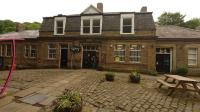
Guest Blog: An interdisciplinary approach to find out “What’s in our Water?”
Khizar Hussain, a student at the University of Huddersfield, shares his experience at a Pennine Heritage “What’s in our Water?” session which he attended with the University of Huddersfield History Society. “What’s in our Water?” is facilitated through a Knowledge Transfer Partnership with the University of Huddersfield.
The day did not get off to a great start with an abundance of cancelled trains, however we managed to get to Dewsbury from Huddersfield just in time for the train over to Hebden Bridge, which was a brief but enjoyable journey and bursting with the stunning aesthetics of Yorkshire. Upon arriving at Hebden Bridge, we were greeted by this charming station with Victorian and art deco influences along with this bold welcome sign highlighting the many centuries of creative heritage in Hebden Bridge!


Following our arrival in Hebden Bridge, we made our way up the steep Birchcliffe hillside to Pennine Heritage. The majestic and grand old building was a sight to behold and very welcoming especially for the members of the group who had found the steep hillside challenging. Upon entering the site, we also came across a beautiful war memorial.

As we got started inside the stunning old Baptist Chapel, we discussed the many different industrial activities that took place in Hebden Bridge and how they link to modern day water pollution the valley. The very informative discussion was led by Dr Jeremy Hopwood (Science Communicator at the University of Huddersfield) and Dr Francesca Elliott (Heritage Manager at Pennine Heritage) who using their expertise in science and history worked to establish how historical factors interact with modern issues in our waters. Dr Rob Ellis (Reader in History at the University of Huddersfield) was also on board to oversee the project and facilitate discussion.
After our fruitful discussion about Hebden Bridge's industrial past, Dr. Jeremy Hopwood explained how we would use scientific methodology to link the past and present. We then took a short walk to neighbouring High Hirst Woodmeadow where Dr Francesca Elliot gave a brief overview of the ecology and biodiversity of the valley before pausing for a moment to take in the vista.

The next step was to walk from the top of Ibbot Royd Clough to the bottom, sampling the water at several points along the way to measure its pH, temperature, and conductivity. As we made our way down the valley, we used these samples to see if we could spot any trends which might point to effects of human activity in the water. Intriguingly, halfway down the valley, we saw a pipe that indicated human activity in the area. At this point, we collected multiple samples to see if we could detect any variations between pre-pipe and post-pipe conditions of the water. We were assisted by Lauren Le Ber and Matthew Gurteen, two postgraduate students who were evaluating the event and assisting with data collection.


We then went back to Pennine Heritage to compile our findings and draw a conclusion about whether Hebden Bridge's industrial past has had any lasting effects on the stream today. Our findings demonstrated consistent readings along the stream, meaning that on this occasion no specific impacts of human activity could be identified. Overall, it was a very enjoyable day bridging history and science, and it clearly demonstrated that learning about history involves more than simply dates and statistics but getting hands on!
